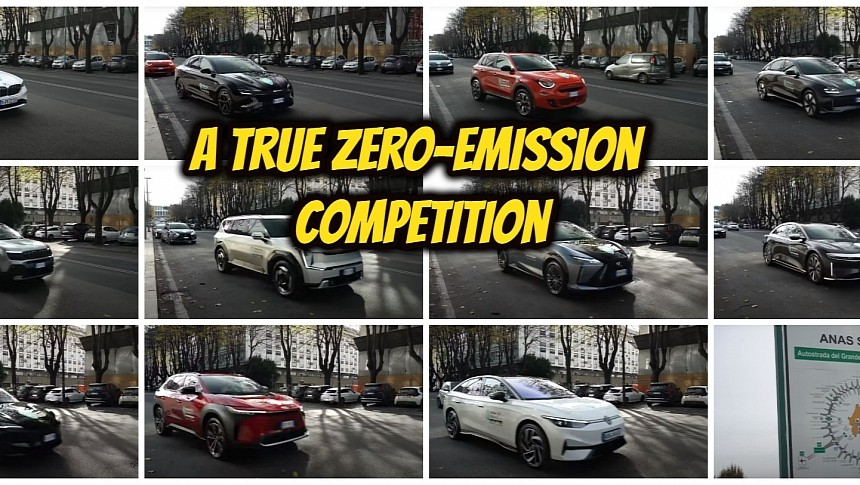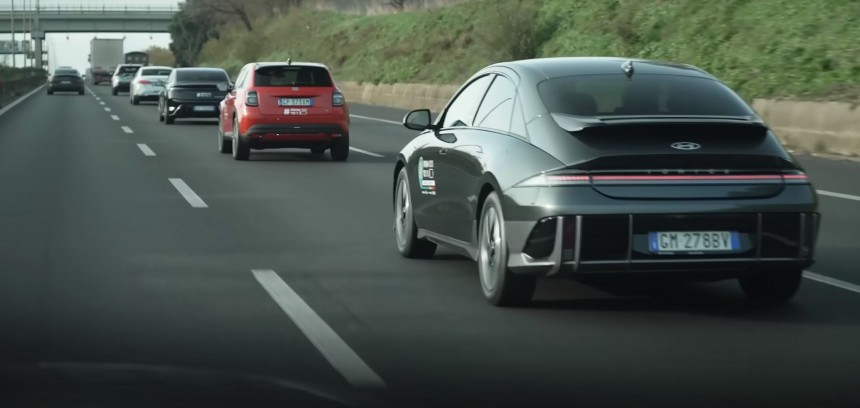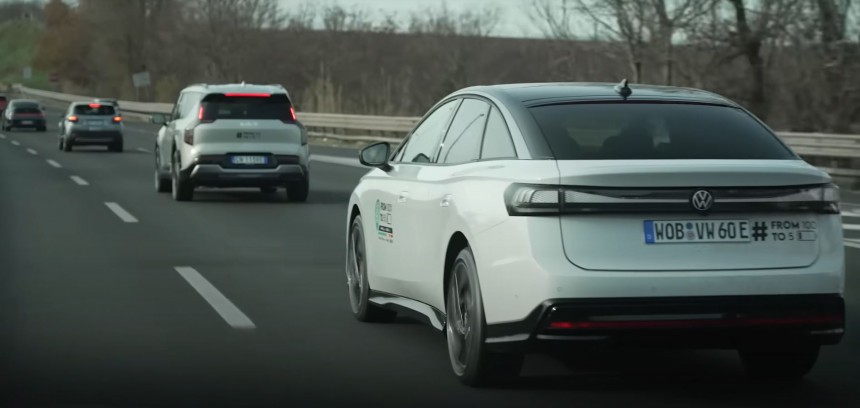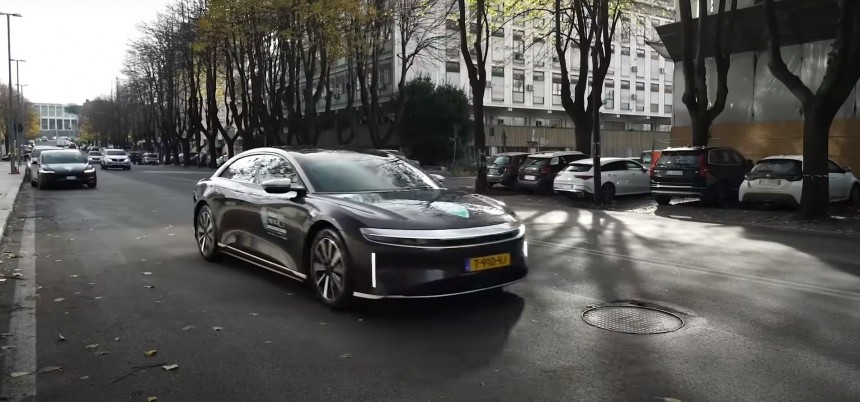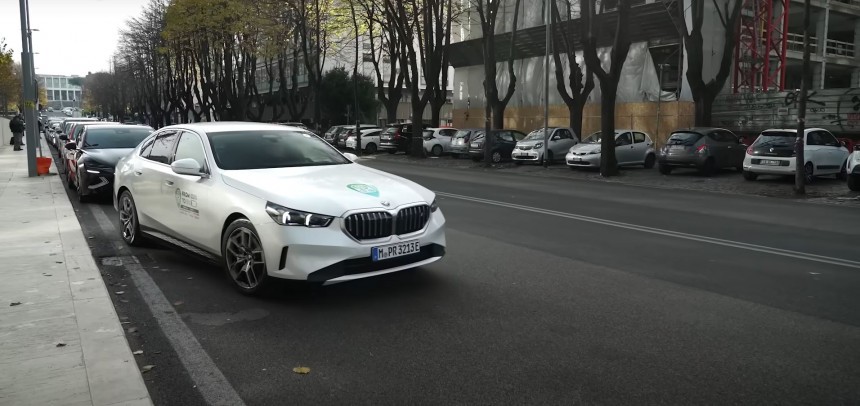As we anticipated, last year's world's best-selling car was none other than the battery-electric Tesla Model Y. It's an important sign. It shows that more and more people looking for new rides are considering a zero-emission car. But what should you choose to make the transition easier? This test will unlock the answer. Grab a drink or a snack because we're in for a in-depth ride!
First things first, we must point out that this type of comparison is hard to organize with press cars. Manufacturers aren't very open to the idea of putting their models in the spotlight when other competitors' vehicles are involved.
That's especially true in cases where different classes are put into a head-to-head. So, props to our fellow German colleagues at Motor1 and InsideEVs for putting all this together.
Secondly, let's meet the cars they drove for this useful test conducted in Italy's capital.
We sorted them based on battery size and omitted the official efficiency (electricity consumption) to keep things simple.
But that's an important metric, so here's how things stand going from the most to the least efficient WLTP-rated test unit:
Thirdly, the test "track" chosen for this range test was Rome's world-famous beltway. Looking somewhat like Porsche's Nardo Ring (originally owned by Fiat), the 42.3-mile-long toll-free motorway helps motorists reach their destination more easily.
However, as it happens almost everywhere in the world, sometimes too many vehicles are on the road. Drivers end up having to put up with queues. It's sad for those caught in congestions where cars should be moving at 110 – 130 kph (68 – 81 mph), but it's great for the purpose of this range test. It reflects what could happen while out and about with one of the abovementioned EVs.
All models were charged to 100% and driven until the 5% state of charge was reached.
Based on the above figures, you might already expect the Lucid and the Tesla to be at the top. Well, you would be right. That's precisely what happened. The former is known for charging extremely fast at low battery levels, while the latter has a reputation for efficiency.
Still, here's how the 11 EVs fared:
Considering the average temperature ranging between 12 and 15 degrees Celsius (54 and 59 degrees Fahrenheit), the active A/C, and the average speed of 60 mph, these results are not bad at all. The first six EVs actually delivered a respectable range.
Digging even deeper, the BMW i5 was the closest to its WLTP range. It covered a distance only 16% shorter than what the people in lab coats got when they verified it. Keep in mind that these experts are running the tests in an environment where the temperature is 23 degrees Celsius (73 degrees Fahrenheit). The average speed is only 46.5 kph (29 mph).
The Bavarians get a gold star, but so do the South Koreans. The EV9 – the only three-row SUV included in the test – was off by only 20% of the WLTP rating.
Already known for not being very good EVs, the Toyota and the Lexus drove 40% less than what the WLTP indicated. Add battery degradation, and you could be looking at half the official range in about three years as an RZ 450e or bZ4x owner.
Lastly, the things that matter the most when choosing a great all-electric vehicle are the size of the battery, the efficiency (how many kWh per mile the EV is consuming), and the charging curve (how long the car can keep replenishing its high-voltage energy storage unit at the fastest charging rate possible).
Arguably, having a service center nearby could also be squeezed in there. After you check all those boxes, you decide on creature comforts, build quality, brand reputation, and other things like cabin space, power output, and options.
The ideal choice for a commuting appliance or a zero-emission company car has been obvious for quite some time. It was the single- or dual-motor Tesla Model 3. However, that ship is slowly but surely sailing. Both new and legacy automakers are coming forward with affordable EVs. It's getting tough out there for the marque that once was the disruptor.
That's especially true in cases where different classes are put into a head-to-head. So, props to our fellow German colleagues at Motor1 and InsideEVs for putting all this together.
Secondly, let's meet the cars they drove for this useful test conducted in Italy's capital.
The numbers that matter
The stars were:- Lucid Air Grand Touring (AWD) – 112 kWh battery, 839 km (521 mi) of WLTP range, 820 hp, 1,200 Nm (885 lb-ft) of torque, 2,360 kg (5,203 lb);
- Kia EV9 (RWD) – 96 kWh battery, 563 km (350 mi) of WLTP range, 201 hp, 350 Nm (258 lb-ft) of torque, 2,426 kg (5,348 lb);
- BYD Seal (RWD) – 82.5 kWh battery, 570 km (354 mi) of WLTP range, 309 hp, 360 Nm (266 lb-ft) of torque, 2,080 kg (4,586 lb);
- BMW i5 eDrive (RWD) – 81.2 kWh battery, 582 km (362 mi) of WLTP range, 335 hp, 430 Nm (317 lb-ft) of torque, 2,130 kg (4,696 lb);
- VW ID.7 (WD) – 77 kWh battery, 621 km (386 mi) of WLTP range, 282 hp, 545 Nm (402 lb-ft) of torque, 2,097 kg (4,623 lb);
- Tesla Model 3 Long Range (AWD) – 75 kWh battery, 629 km (391 mi) of WLTP range, 491 hp, 493 Nm (364 lb-ft) of torque, 1,828 kg (4,030 lb);
- Hyundai Ioniq 6 (RWD) – 74 kWh battery, 614 km (382 mi) of WLTP range, 225 hp, 350 Nm (258 lb-ft) of torque, 1,910 kg (4,211 lb);
- Toyota bZ4x (AWD) – 64 kWh battery, 419 km (260 mi) of WLTP range, 215 hp, 337 Nm (249 lb-ft) of torque, 2,000 kg (4,409 lb);
- Lexus RZ 450e (AWD) – 64 kWh battery, 406 km (252 mi) of WLTP range, 309 hp, 435 Nm (321 lb-ft) of torque, 2,055 kg (4,530 lb);
- Fiat 600e (FWD) – 51 kWh battery, 409 km (254 mi) of WLTP range, 154 hp, 260 Nm (192 lb-ft) of torque, 1,520 kg (3,351 lb);
- Jeep Avenger (FWD) – 51 kWh battery, 401 km (249 mi) of WLTP range, 154 hp, 260 Nm (192 lb-ft) of torque, 1,520 kg (3,351 lb).
We sorted them based on battery size and omitted the official efficiency (electricity consumption) to keep things simple.
But that's an important metric, so here's how things stand going from the most to the least efficient WLTP-rated test unit:
- Tesla Model 3 Long Range – 13.2 kWh per 100 km / 4.7 mi per kWh;
- VW ID.7 - 14.1 kWh per 100 km / 4.4 mi per kWh;
- Hyundai Ioniq 6 – 14.3 kWh per 100 km / 4.3 mi per kWh;
- Lucid Air Grand Touring – 14.9 kWh per 100 km / 4.2 mi per kWh;
- Fiat 600e – 15.1 kWh per 100 km / 4.1 mi per kWh;
- Jeep Avenger – 15.4 kWh per 100 km / 4 mi per kWh;
- BMW i5 eDrive40 – 15.9 kWh per 100 km / 3.9 mi per kWh;
- BYD Seal – 16.6 kWh per 100 km / 3.7 mi per kWh;
- Toyota bZ4x – 17.8 kWh per 100 km / 3.5 mi per kWh;
- Lexus RZ 450e – 18.2 kWh per 100 km / 3.4 mi per kWh;
- Kia EV9 – 20.2 kWh per 100 km / 3 mi per kWh. [don't forget that it's a three-row eSUV]
Thirdly, the test "track" chosen for this range test was Rome's world-famous beltway. Looking somewhat like Porsche's Nardo Ring (originally owned by Fiat), the 42.3-mile-long toll-free motorway helps motorists reach their destination more easily.
All models were charged to 100% and driven until the 5% state of charge was reached.
An interesting outcome
Once again, that makes more sense than driving until the battery is depleted. Some EVs may have a "secret" energy reserve available after a 0% state of charge is shown on the driver's display. Still, most owners will try to find a dispenser or a domestic socket before that anxiety-inducing level of charge is reached.Based on the above figures, you might already expect the Lucid and the Tesla to be at the top. Well, you would be right. That's precisely what happened. The former is known for charging extremely fast at low battery levels, while the latter has a reputation for efficiency.
- Lucid Air GT – 571 km (355 mi);
- Tesla Model 3 LR – 498 km (309 mi);
- BMW i5 eDrive40 – 489 km (304 mi);
- Hyundai Ioniq 6 – 476 km (296 mi);
- BYD Seal – 452 km (281 mi);
- Kia EV9 – 448 km (278 mi);
- VW ID.7 – 400 km (249 mi);
- Fiat 600e – 282 km (175 mi);
- Jeep Avenger – 275 km (171 mi);
- Toyota bZ4x – 249 km (155 mi);
- Lexus RZ 450e – 243 km (151 mi).
Considering the average temperature ranging between 12 and 15 degrees Celsius (54 and 59 degrees Fahrenheit), the active A/C, and the average speed of 60 mph, these results are not bad at all. The first six EVs actually delivered a respectable range.
Conserving electrons
However, things look a tad bit different when you're looking at the consumption. Here's how efficient these EVs were:- Tesla Model 3 LR – 15.1 kWh per 100 km / 4.1 mi per kWh;
- Hyundai Ioniq 6 – 15.5 kWh per 100 km / 4 mi per kWh;
- BMW i5 – 16.6 kWh per 100 km / 3.7 mi per kWh;
- Fiat 600e – 18.1 kWh per 100 km / 3.4 mi per kWh;
- BYD Seal – 18.3 kWh per 100 km / 3.4 mi per kWh;
- Jeep Avenger – 18.5 kWh per 100 km / 3.3 mi per kWh;
- VW ID.7 – 19.3 kWh per 100 km / 3.2 mi per kWh;
- Lucid Air – 19.6 kWh per 100 km / 3.2 mi per kWh;
- Kia EV9 – 21.4 kWh per 100 km / 2.9 mi per kWh;
- Toyota bZ4x – 25.7 kWh per 100 km / 2.4 mi per kWh;
- Lexus RZ 450e – 26.3 kWh per 100 km / 2.3 mi per kWh.
Digging even deeper, the BMW i5 was the closest to its WLTP range. It covered a distance only 16% shorter than what the people in lab coats got when they verified it. Keep in mind that these experts are running the tests in an environment where the temperature is 23 degrees Celsius (73 degrees Fahrenheit). The average speed is only 46.5 kph (29 mph).
The Bavarians get a gold star, but so do the South Koreans. The EV9 – the only three-row SUV included in the test – was off by only 20% of the WLTP rating.
A couple of things to remember
The lesson offered to us for free here is never to fully trust official ratings. They do not indicate what the dashboard will show every time when you're heading out for a drive. WLTP, especially, is more permissive than what the EPA is doing and may paint a picture that's too optimistic.Lastly, the things that matter the most when choosing a great all-electric vehicle are the size of the battery, the efficiency (how many kWh per mile the EV is consuming), and the charging curve (how long the car can keep replenishing its high-voltage energy storage unit at the fastest charging rate possible).
Arguably, having a service center nearby could also be squeezed in there. After you check all those boxes, you decide on creature comforts, build quality, brand reputation, and other things like cabin space, power output, and options.
The ideal choice for a commuting appliance or a zero-emission company car has been obvious for quite some time. It was the single- or dual-motor Tesla Model 3. However, that ship is slowly but surely sailing. Both new and legacy automakers are coming forward with affordable EVs. It's getting tough out there for the marque that once was the disruptor.
